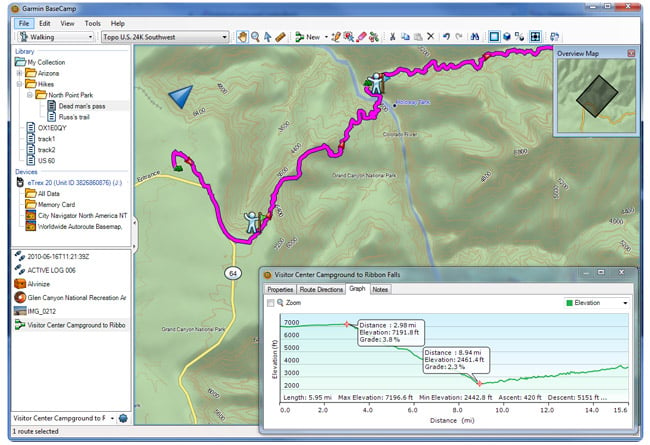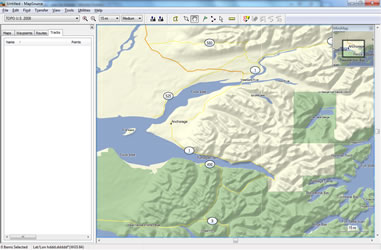Main Menu
How To Open Maps In Garmin Basecamp Manual Pdf
суббота 23 марта admin 95
• • • • • • • Some Basics about sending maps to your GPS device ATTENTION - Basecamp 4.7.0 (or better MapInstall 4.2.0) is partly broken. Best downgrade (or even better never upgrade to 4.7.0) to Basecamp 4.6.2 - see also here: There are a few possibilities to send maps to your GPS Device. As I assume you are using Garmin Basecamp - the easiest is to just send them from Garmin Basecamp. And fastest way of sending is always to the microSD card - in a cardreader - because most Garmin devices devices don't have fast USB chips.
Alternatively for Windows users only - you could scroll down to the explications how to send maps with Mapsource - this has the advantage of having a full screen map selection possibility - while the Mapinstall windows to select the tiles is a bit small. Otherwise there are no advantages.
Mikrotik blokirovka torrentov. Easy installation in Garmin Mapsource, Garmin Basecamp or Qlandkarte GT to. The OSx tutorial too:.
Amimon inc. WY Amimon Whdi Driver Download. We test Amimon's WHDI Stick, which is designed to wirelessly transmit video from any HDMI-equipped device to an HDTV. Amimon’s WHDO stick has a 3GB per second wireless transmission using the unlicensed 5 GHz transmission band. It uses a dual port system and an HDMI receiving device that hooks up directly to the TV. WHDI revolutionizes the home multimedia experience by wirelessly delivering interactive HD video from any device to any display.

For Linux Users - the easiest is to send maps using Qlandkarte GT - please read the Qlandkarte GT tutorial for that. Last you could generate the gmapsupp.img with mkgmap - then put it on your microSD - there is another tutorial for this, but it's a bit more complicated (only advantage is that it's a bit faster).
Please note - you cannot install the maps on the microSD. You always first install the maps to your PC/Mac - then send them - or send a selection of the map. Also note - the maximum number of map tiles your device can read in is around 2000 or 4000 map tiles - so if you install more - some maps simply will not be read in. So as general advice - only send those maps to your device - which you will likely need in near future. (I try to make the map tiles as big as possible - around 13MB average per tile - but other maps - especially older Garmin maps may have tiles of only 1MB) Differences between old and new generation Garmin GPS Devices: new generation GPS devices (Oregon, Dakota, Colorado, etrex 20/30, GPS Maps 62 or 64 series, edge 800/1000.) All maps sent at once will appear as one map on your map selection setup on the GPS device. If you want to be able to switch maps on/off separately, then send them once, and rename the GMAPSUPP.IMG into anything else (well the.IMG needs to stay) - but don't use Umlauts, special symbols or spaces in the name. Then just sent the next map.
This makes it very easy to manage your maps. You can simply export map by map and rename it. If you want to upload a new updated map, delete the old map you previously sent, and send only the new map again.
Old generation GPS devices (Vista, Legend, 60 CSx, edge 705.) On older generation Garmin GPS devices (e.g. Vista HCx, Gpsmaps 60 CSx, edge 705) you can only send 1 map compilation called GMAPSUPP.IMG This means you need to send all maps at once to the GPS/memory card, maps (except basemap) previously sent will be overwritten. If you want to be able to switch the contourlines on/off on your GPS device, best install it as a separate map in Mapsource/Basecamp, then select first the normal map and delete all 7* (e.g. (73650000)) from the list on the left hand side, and then select the map tiles from the contourlines only openmtbmap. Sending Maps with Basecamp/Mapinstall to your Garmin GPS device: Note - while sending maps with MapInstall is easier and less errorprone - the drawback vs Mapsource is - that the selection window for the map is rather small. Otherwise there is no reason to use Mapsource anymore.
A) Insert the memory card of your GPS into a memory card reader, and wait till it is read in in Basecamp. Then click on 'Maps' menu - and at the end of it click on 'Install Maps': Select where to install the maps - best send them directly to an SD card - and not to an device as shown in the following Screenshot (its slower, and second it's always safer to send maps to memory cards and not to internal memory - should something go wrong you can simply take the memory card out): 1. B) Insert the memory card of your GPS into a memory card reader, and wait till it is read in in Basecamp. It will show you all previously installed maps (note check if they are called gmapsupp.img - in that case they will be overwritten). Right click the ALL Data folder and click on 'Install Maps on.'
